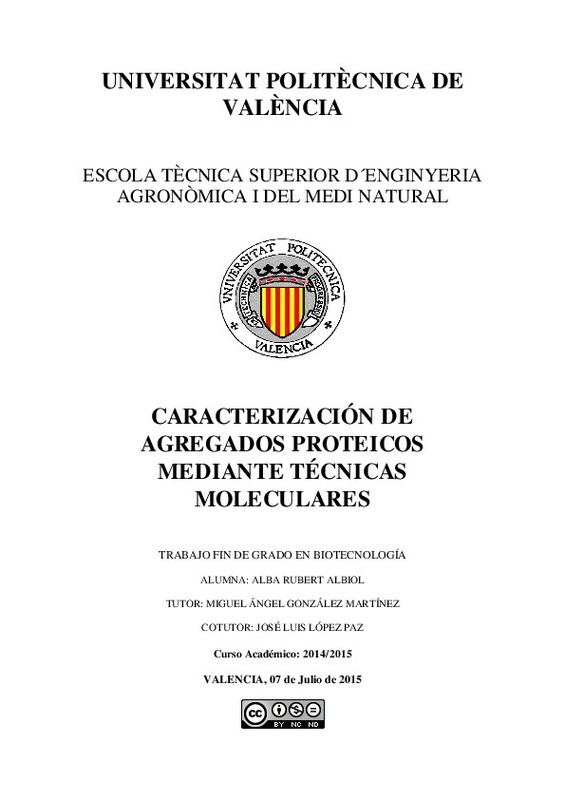JavaScript is disabled for your browser. Some features of this site may not work without it.
Buscar en RiuNet
Listar
Mi cuenta
Estadísticas
Ayuda RiuNet
Admin. UPV
Caracterización de Agregados Proteicos Mediante Técnicas Moleculares
Mostrar el registro sencillo del ítem
Ficheros en el ítem
| dc.contributor.advisor | López Paz, José Luis
|
es_ES |
| dc.contributor.advisor | González Martínez, Miguel Ángel
|
es_ES |
| dc.contributor.author | Rubert Albiol, Alba
|
es_ES |
| dc.date.accessioned | 2015-09-04T15:16:23Z | |
| dc.date.available | 2015-09-04T15:16:23Z | |
| dc.date.created | 2015-07-17 | |
| dc.date.issued | 2015-09-04 | es_ES |
| dc.identifier.uri | http://hdl.handle.net/10251/54303 | |
| dc.description.abstract | [EN] The work is devoted to characterize proteic aggregates, concretely the binding of immunoglobulins to membrane proteins, employing molecular label free methods such as dual polarization interferometry DPI. Receptor proteins will be covalently immobilized on the sensor surface, using different anchoring procedures; and ligand proteins (human IgGs) will bind to the derivatized surface. Thickness, mass and density increments on the sensing element are continuously and at real time displayed, for both anchoring and binding processes. These parameters allow quantifying affinity and kinetics of the interaction, as well as observing conformational changes induced on proteins or other molecules involved. Results will enable to retrieve information helpful for better understanding the behavior of proteins in the solid-liquid interface, and the conformational dynamics of protein-protein interactions, thus improving the knowledge of their function. | es_ES |
| dc.description.abstract | [ES] En el presente trabajo se van a caracterizar agregados proteicos, en particular se estudiará la unión de inmunoglobulinas a proteínas de membrana, empleando métodos moleculares label-free como el DPI. Las proteínas receptoras se inmovilizarán covalentemente sobre la superficie del sensor, utilizando diferentes procedimientos de anclaje, y las proteínas ligando (IgGs humanas) se unirán a la superficie derivatizada, registrándose en continuo y a tiempo real, para ambos procesos, el incremento en el espesor, la masa y la densidad sobre la superficie del elemento sensor. Estos parámetros permiten cuantificar las afinidades de la interacción y su cinética, así como observar cambios conformacionales inducidos en las proteínas y/o moléculas participantes. Los resultados permitirán obtener información que ayude a comprender mejor el comportamiento de las proteínas en la interfase sólido-líquido y la dinámica conformacional de las interacciones proteína-proteína, y así conocer mejor su función. | es_ES |
| dc.language | Español | es_ES |
| dc.publisher | Universitat Politècnica de València | es_ES |
| dc.rights | Reconocimiento - No comercial - Sin obra derivada (by-nc-nd) | es_ES |
| dc.subject | Dual Polarization Interferometry | es_ES |
| dc.subject | Immunoglobulin G | es_ES |
| dc.subject | Protein-protein interaction | es_ES |
| dc.subject | Interferometría de Polarización Dual | es_ES |
| dc.subject | Inmunoglobulina G | es_ES |
| dc.subject | Interacción proteína-proteína | es_ES |
| dc.subject.classification | QUIMICA ANALITICA | es_ES |
| dc.subject.other | Grado en Biotecnología-Grau en Biotecnologia | es_ES |
| dc.title | Caracterización de Agregados Proteicos Mediante Técnicas Moleculares | es_ES |
| dc.type | Proyecto/Trabajo fin de carrera/grado | es_ES |
| dc.rights.accessRights | Abierto | es_ES |
| dc.contributor.affiliation | Universitat Politècnica de València. Departamento de Química - Departament de Química | es_ES |
| dc.contributor.affiliation | Universitat Politècnica de València. Escuela Técnica Superior de Ingeniería Agronómica y del Medio Natural - Escola Tècnica Superior d'Enginyeria Agronòmica i del Medi Natural | es_ES |
| dc.description.bibliographicCitation | Rubert Albiol, A. (2015). Caracterización de Agregados Proteicos Mediante Técnicas Moleculares. http://hdl.handle.net/10251/54303. | es_ES |
| dc.description.accrualMethod | TFGM | es_ES |
| dc.relation.pasarela | TFGM\22003 | es_ES |
Este ítem aparece en la(s) siguiente(s) colección(ones)
-
ETSIAMN - Trabajos académicos [3541]
Escuela Técnica Superior de Ingeniería Agronómica y del Medio Natural






